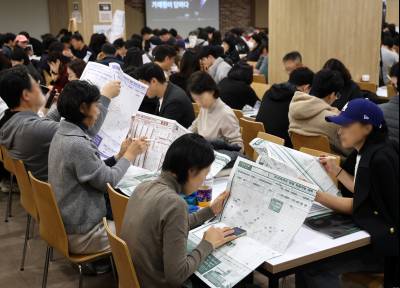- 첨단기술로 만드는 애완견 의족

JUST HIT PAWS
Vets can now obrder up carbon fiber and 3-D printed prosthetic limbs for injured cats and dogs.When animal rescue took Noah from his former owner’s house and brought the German shepherd to Houston’s VERGI emergency hospital in late September, Dr. Sarah Dewhirst was “horrified by the neglect and abuse” she saw. The fur and pads were gone from Noah’s right front paw; all that was left was exposed bones and infected tissue. “My initial reaction was just to amputate at the shoulder,” says the veterinarian, citing standard practice for severely injured dogs.
Then a colleague told Dewhirst about Bill Bickley, founder of the Houston-based Pet Artificial Limbs and Supports (PALS). Bickley, 46, is a new breed of specialist, creating animal orthotics and prosthetics. For over a decade, he worked on human limbs. Then, three years ago, Bickley read about the small but growing field of animal orthotics and prosthetics, pioneered in the first years of this century largely by Martin and Amy Kaufmann, founders of Colorado-based OrthoPets; Jeff Collins of K-9 Orthotics and Prosthetics in Nova Scotia; and Derrick Campana of Animal Ortho Care in Virginia.
The industry giant is OrthoPets, which started accidentally in 2002 when a cousin’s schnauzer had a stroke and needed an orthotic. Soon the Kaufmanns turned a 400-square-foot garage into an orthotics and prosthetics facility, and in 2007 they made OrthoPets their full-time focus. Now they have 21 employees and 200 patients a month via distribution centers all over the world. Using videos, pictures and details from veterinarians, they work with clients in South America, Europe and Asia.
Still, Bickley saw room for innovation. Most limbs he saw “were heavy-duty without a lot of finesse—they had no bounce or natural motion.” So Bickley started pondering and tinkering, finally hitting on the idea of using carbon fiber, which is both strong and flexible; it’s the material of the blades for runners who are amputees. But Bickley needed some carbon fiber to actually test the idea. The first five places he called “either laughed at me or said they’d only do it for a big production run and a lot of money.” He left a voice mail for Hans DeBot, whose company, deBotech, has used carbon fiber to help build everything from Olympic bobsleds to military aircraft and Lamborghinis. Bickley was simply hoping DeBot might recommend a smaller operator willing to help.
“But I have three dogs and love animals, so I said, ‘I’ll help you, and we’ll worry about the cost later,’” DeBot says. The two collaborated on the project, testing prototypes until they hit an idea: different “spring rates” based on the size of the dog for the carbon fiber blades that act as the dog’s legs. Eventually, they also fine-tuned a back leg with progressive stiffness, DeBot says, going from less flexible up top to more pliant near the bottom. Bickley then created a “foot” by injecting silicone gel into a cup pad at the bottom of the leg to provide the dog with a softer landing.
The other leaders in the field have their own approaches and innovations. At OrthoPets, for example, the company takes a fiberglass impression of a limb, scans it and makes a 3-D model. A machine carves the final shape from a block of foam. Then the prosthesis gets vacuum-sealed with plastic.
While Bickley still earns much of his living working with humans, in two years he has built up recognition locally. He helps mostly dogs, but he has also provided a knee brace for a flamingo at the local zoo and a prosthetic leg for a ram. One prosthetic dog leg typically costs around $1,500, plus $100 in annual maintenance because the dogs chew the straps that connect the artificial limb to their leg.
“He has made a huge difference in the services we provide,” says Dr. Brian Beale, a surgeon at Gulf Coast Veterinary Specialists in Houston. “The carbon fiber provides more flexibility and probably feels more natural to the dog, so they can really run on these things.” Beale also praises Bickley’s orthotics — custom braces, for example — and explains that while the prosthetic is the more dramatic fix, the orthotics can often help a pet avoid surgery. (All the companies say orthotics is 80 to 90 percent of their business.)
The field is so new that there’s no formal education or licensing program, nor have any real studies been conducted about the impact of orthotics and prosthetics. Beale says, for many vets, “the mindset is still just to cut the leg off and assume the other three are good enough,” though he thinks that will change if vets and owners see the difference a prosthetic makes. Dewhirst says living on three legs can “lead to arthritis and potentially decrease a dog’s life span.” But when she was in school in 2009, she heard of only occasional cases of prosthetic work, which is why her instinct had been to amputate Noah’s leg at the shoulder.
Fortunately for Noah, Dewhirst heard about the new prosthetics. After she reached out to Bickley, a local animal rescue group started a social media campaign to raise awareness and money for his new leg. Then Dewhirst performed the operation that would allow Bickley to attach the prosthetic leg. The operation was a success, and now Noah’s walking around on all fours again.
Bickley, Campana and Martin Kaufmann try to spread the word to vets at surgical conferences and to owners at dog clubs and pet expos. “There’s a lot more awareness than there was five years ago,” says Amy Kaufmann. In some veterinary schools, animal prosthetics have already become part of the curriculum. Dr. Jamie Peyton, service chief at the UC Davis Veterinary Medical Teaching Hospital’s Integrative Medicine Service, says her students attend lectures on the subject and a weekly clinic in which she works with orthotists and prosthetists on not only dogs and cats but also livestock.
In addition, Peyton serves on a committee at the American Association of Rehabilitation Veterinarians, whose goal is to spread the word on animal orthotics and prosthetics to other universities. And the Kaufmanns have written a textbook on the subject due in 2016 that they think will further fuel awareness. “It will change standard protocol taught in veterinary schools,” Amy Kaufman says.
“The textbook will be valuable,” says Peyton, “but what is really going to change people’s minds is when they see the difference. And the best exposure is clinical exposure—when they see a dog with three legs, and then they see a dog running more naturally with a prosthetic.”
첨단기술로 만드는 애완견 의족
부상한 고양이와 개를 위한 보철 제작에 탄소섬유나 3D 프린팅까지 사용해지난 9월 말 미국 텍사스주 휴스턴의 동물구조팀은 주인에게 학대 당하던 저먼 셰퍼드 노아를 구출했다. 노아는 곧바로 VERGI 동물 응급병원으로 후송됐다. 그 병원의 새러 드워스트 박사는 “노아가 당한 학대와 방치의 증거를 보자 치가 떨렸다”고 말했다. 노아는 오른쪽 앞발 끝에 발바닥과 털이 없었다. 그 부분의 뼈가 드러나고 조직이 감염된 상태였다. 드워스트 박사는 “처음엔 노아의 어깨 부분을 절단하는 수밖에 없다고 생각했다”고 돌이켰다. 절단은 심하게 부상한 개의 표준 치료법이다.
그때 한 동료가 애완동물 인공 다리와 보장구(PALS)라는 회사를 설립한 빌 비클리에게 연락해보면 어떻겠느냐고 제안했다. 비클리는 10년 넘게 사람의 의족과 의수를 연구했다. 그러다가 3년 전 동물 보철에 관한 기사를 읽었다. 2000년대 초 새로 등장한 분야였다. 콜로라도주에서 오소페츠를 설립한 마틴과 에이미 카우프만 부부, 캐나다 노바스코샤주에서 K-9 오소틱스 앤 프로스테틱스를 설립한 제프 콜린스, 버지니아주에서 애니멀 오소케어를 설립한 데릭 캄파냐가 동물 보철의 선구자였다.
가장 잘 알려진 회사는 오소페츠다. 2002년 카우프만 부부의 사촌이 사랑하던 애완견 슈나우저가 뇌졸중에 걸려 잘 걷지 못해 보장구가 필요했다. 그들은 차고에서 다리 지지대를 만들기 시작했고 2007년부터는 오소페츠를 전업으로 삼았다. 현재 직원이 21명이며 한 달에 치료하는 동물환자가 200마리다. 그들은 동영상, 사진, 수의사가 제공하는 진료 기록을 사용해 남미·유럽·아시아의 고객에게 서비스를 제공한다.
하지만 비클리 대표는 혁신이 필요하다고 생각했다. 그는 “대부분의 동물 보철은 무겁고 투박해 자연스럽지 않았다”고 말했다. 비클리 대표는 오랜 실험 끝에 탄소섬유를 사용해보기로 했다. 강하고 유연하며 다리를 절단한 달리기 선수들의 블레이드에 사용하는 소재다. 비클리는 여러 업체에 연락했지만 “그들은 말도 안된다며 웃어 넘기거나 대규모 제작만 가능하며 비용이 많이 든다고 말했다”고 돌이켰다. 그는 ‘드보테크’라는 회사의 대표 한스 드보에게 음성 메일을 남겼다. 그 회사는 탄소섬유를 사용해 올림픽용 봅슬레이와 군용 비행기, 고급 스포츠카를 제작하는 일에 참여한다. 그가 소규모 업체를 추천하거나 소개해줄지 모른다고 생각했다.
드보 대표는 “난 개 세 마리를 기르는데 동물을 좋아한다”며 “그래서 비클리에게 ‘비용은 나중에 걱정하고 한번 해보자’는 제안을 했다”고 돌이켰다. 그들은 여러 차례의 실험 끝에 몸집에 기초한 탄성률을 계산해 개의 다리 역할을 하는 탄소 섬유 블레이드를 만들었다. 뒷다리의 경우 윗부분은 덜 유연하고 끝부분은 좀 더 유연하게 처리했다. 그 다음 부드러운 착지를 위해 다리 끝에 실리콘젤을 주입한 컵 패드를 부착했다.
이 분야의 다른 선구자들도 혁신에 뛰어들었다. 오소페츠는 개의 다리를 스캔해 3D 모델을 만든다. 그 다음 기계를 사용해 발포 고무로 최종 형태를 만들고 플라스틱으로 진공 밀폐한다.
비클리 대표는 2년 만에 지역 사회에서 알려졌다. 그는 개의 보철이 전문이지만 동물원의 플라밍고의 무릎 보장구와 양의 보철 다리를 만들기도 했다. 개 의족 제작에 약 1500달러, 연간 유지비로 100달러가 든다(개는 의족을 연결하는 끈을 자주 물어 뜯는다).
휴스턴의 수의사 브라이언 빌 박사는 “우리가 동물에게 제공하는 서비스에 그가 중요한 기여를 한다”고 말했다. “탄소섬유는 유연하고 더 자연스런 느낌을 준다. 개는 탄소섬유 의족으로 실제로 뛰어다닐 수 있다.” 빌 박사는 비클리 대표가 만드는 보장구(예를 들어 주문형 지지대)도 높이 평가했다. 그는 보철이 정교한 해결책이라면 보장구는 수술하지 않고 동물이 걸을 수 있도록 도움을 준다고 설명했다(관련 기업들은 사업의 80∼90%가 보철이 아니라 보장구라고 말했다).
이 분야는 아직 초기 단계라 정식 교육이나 면허 프로그램이 없다. 애완동물의 보장구와 보철의 효과에 관한 연구도 거의 이뤄지지 않았다. 빌 박사는 “대다수 수의사는 동물의 다리를 절단한 뒤 나머지 세 다리가 튼튼해 어느 정도 활동할 수 있기를 기대할 뿐”이라고 말했다. 그러나 보철의 효과를 알면 그런 생각이 바뀔 것이라고 생각한다. 드워스트 박사는 “개가 세 다리로 걸어다니다 보면 관절염에 잘 걸려 수명이 짧아질 수 있다”고 말했다. 하지만 그는 2009년 수의학을 배울 땐 보철에 관한 이야기는 거의 들어보지 못했다. 그래서 노아를 처음 봤을 때 곧바로 절단을 생각했다.
다행히 노아가 찾아 왔을 때 드워스트 박사는 새로운 보철 기술에 관한 소식을 들었다. 현지의 동물구조단체는 노아의 새로운 다리 제작에 필요한 자금을 모으고 보철에 관한 인식을 제고하는 소셜미디어 캠페인을 벌였다. 드워스트 박사는 보철 다리를 부착할 수 있도록 노아를 수술했다. 지금 노아는 네 다리로 걸어다닐 수 있다.
비클리와 캄파냐, 카우프만 부부는 학술대회에서 수의사들에게, 애완견 클럽과 엑스포에서 개의 주인에게 그런 정보를 전달한다. 에이미 카우프만은 “5년 전보다 인식이 크게 개선됐다”고 말했다. 일부 수의학교는 교육과정에 동물 보철을 도입했다. 캘리포니아대학(데이비스 캠퍼스) 부속 동물병원의 통합의학 서비스 책임자 제이미 페이턴 박사는 학생들이 개와 고양이만이 아니라 가축의 보장구와 보철에 대한 강의를 듣고 실습도 한다고 말했다.
페이턴 박사는 미국 재활전문 수의사 협회에서 동물 보장구와 보철에 관한 정보를 학계에 알리는 위원회에서도 활동한다. 카우프만 부부는 동물 보장구와 보철에 관한 교과서를 집필했다. 그 교과서는 내년부터 사용될 예정이다. 에이미 카우프만은 “새 교과서가 수의학교에서 가르치는 표준 프로토콜을 바꿔놓을 것”이라고 말했다. 페이턴 박사는 “교과서도 중요하지만 실제 차이를 보면 생각이 완전히 달라질 것”이라고 말했다. “세 다리로 어렵게 걷는 개를 보다가 의족으로 자연스럽게 뛰는 개를 보면 어떤 생각이 들겠는가?”
- STUART MILLER NEWSWEEK 기자 / 번역 이원기
ⓒ이코노미스트(https://economist.co.kr) '내일을 위한 경제뉴스 이코노미스트' 무단 전재 및 재배포 금지










![갓 잡은 갈치를 입속에... 현대판 ‘나는 자연인이다’ 준아 [김지혜의 ★튜브]](https://image.isplus.com/data/isp/image/2025/11/21/isp20251121000010.400.0.jpg)
![딱 1분… 숏폼 드라마계 다크호스 ‘야자캠프’를 아시나요 [김지혜의 ★튜브]](https://image.isplus.com/data/isp/image/2025/11/09/isp20251109000035.400.0.jpg)



당신이 좋아할 만한 기사
브랜드 미디어
브랜드 미디어
은행 대출금리에 '법적비용' 전가 못한다…위반시 행정제재
세상을 올바르게,세상을 따뜻하게일간스포츠
일간스포츠
이데일리
변요한♥티파니 영, '애정 가득' 자필 편지
대한민국 스포츠·연예의 살아있는 역사 일간스포츠일간스포츠
일간스포츠
일간스포츠
`광주 도서관 붕괴` 시공사 압수수색, 관계자 출국금지…수사 속도(종합)
세상을 올바르게,세상을 따뜻하게이데일리
이데일리
이데일리
불닭볶음면이 만든 1조 매출…삼양식품 신용등급도 상승세
성공 투자의 동반자마켓인
마켓인
마켓인
[용호상박 K바이오] ADC ‘항체’ 기반 지놈앤컴퍼니와 에임드바이오
바이오 성공 투자, 1%를 위한 길라잡이팜이데일리
팜이데일리
팜이데일리